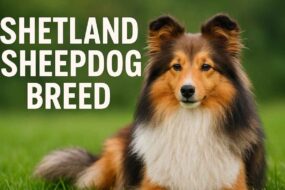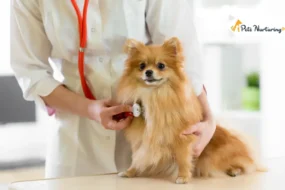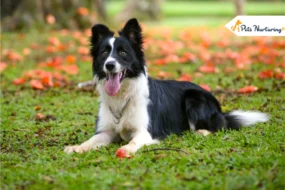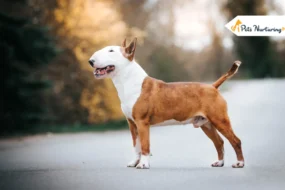
People often look for three qualities when choosing a dog breed – cuteness + friendliness + adaptability. And there is one dog that checks all these three boxes! Want to take a guess? Yes, we are talking about none other than the Pug dog breed.
Pugs have adorable faces with big, round eyes and deep wrinkles that make them look like little clowns. They’re playful but also love being close to their humans. In terms of personality, these dogs are loyal, happy, and playful, but they can be stubborn during training. The best thing is that they can easily adapt to different living situations. If you are planning to buy a Pug, read our guide. We’ll share all the important information about the breed, including their history, characteristics, and care needs.
Pug Dog Breed Overview
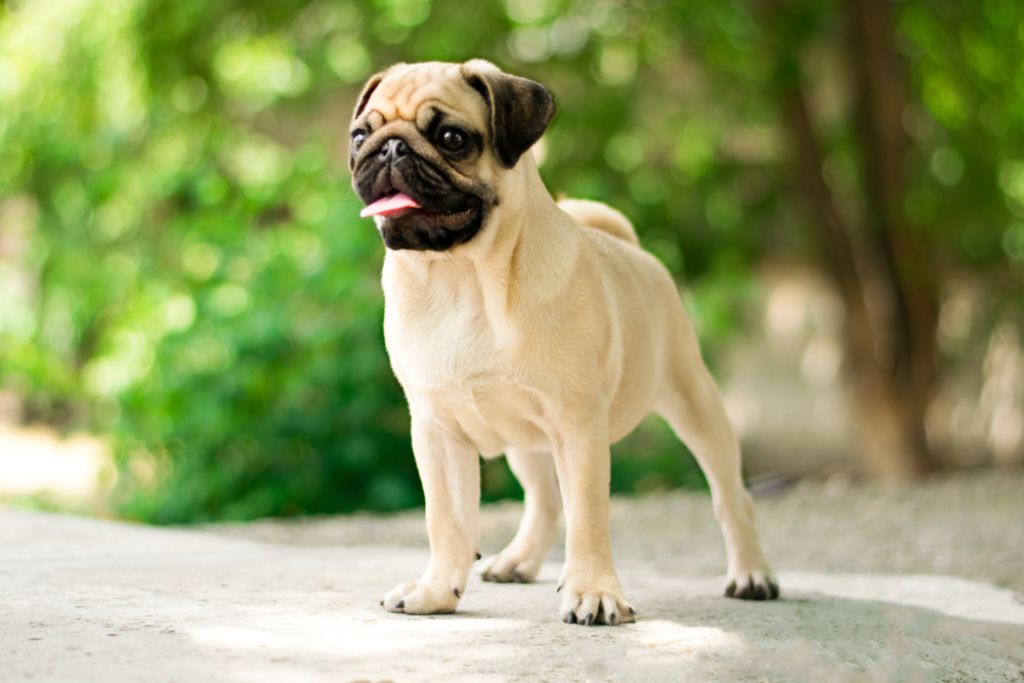
Pug Dog
Breed Name: Pug
Breed Group: Toy
Height: 10 to 13 inches
Weight: 14 to 18 pounds
Lifespan: 13 to 15 years
Coat: Short, double coat
Color: Fawn, black
Temperament: Affectionate, playful, loyal
Grooming Needs: Moderate
Hypoallergenic: No
Origin: China
Pugs were originally bred to be lapdogs for Chinese emperors.
History
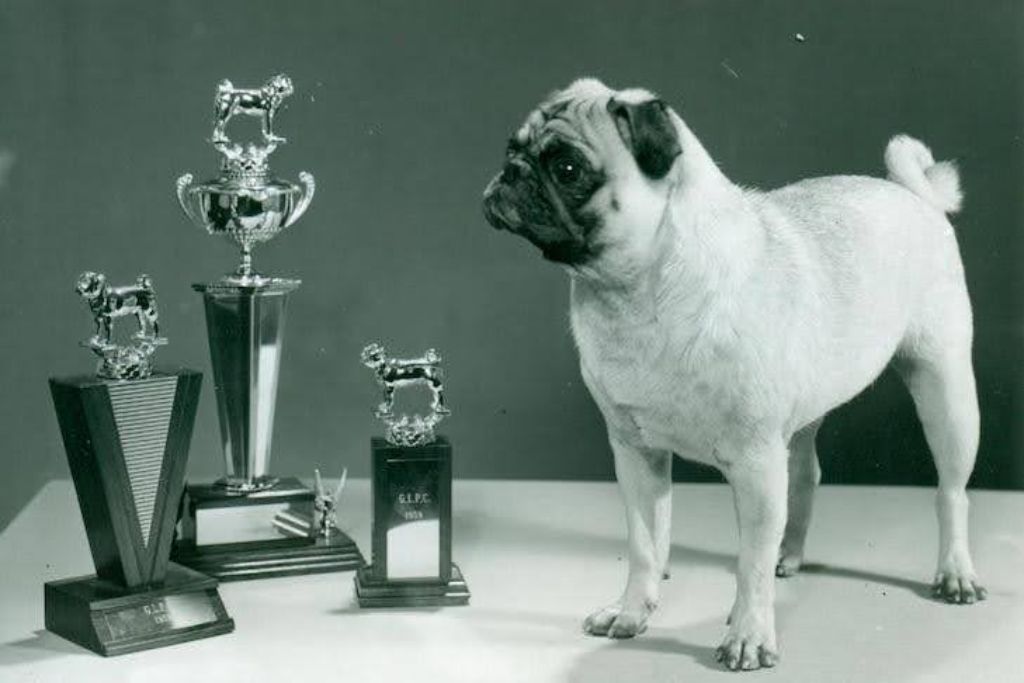
The Pug has a long history dating back to around 400 BC. They are believed to be one of the oldest dog breeds, originating around 2,000 years ago in China.
The Pug’s ancestor was a dog called the Lo-Chiang-Sze, often shortened to Lo-Sze. This name describes a dog with short legs, a short muzzle, and a short coat.
These small, flat-faced dogs were favored by Chinese emperors and lived luxurious lives. They were exclusively given as gifts outside of China. When Dutch traders introduced them to Europe in the 1500s and early 1600s, pugs quickly gained popularity among royal households, spreading across the continent.
Throughout history, pugs have been known by various names in different languages, including,
- Lo-sze (Chinese)
- Doguillo (Spanish)
- Mopsi (Finnish)
- Mophonds (Dutch)
During the Victorian era, pugs were extremely popular and featured in postcards, art, and collectible figurines. They were primarily pets of the aristocracy, with Marie Antoinette and Queen Victoria being notable owners.
The breed was standardized in the early 1800s. English breeders further developed them after discovering pugs in the Chinese Imperial Palace in 1860.
Pugs arrived in the United States after the Civil War and were officially recognized by the American Kennel Club in 1885. Although their popularity initially declined, it surged again in the 1930s with the establishment of the Pug Dog Club of America.
Appearance
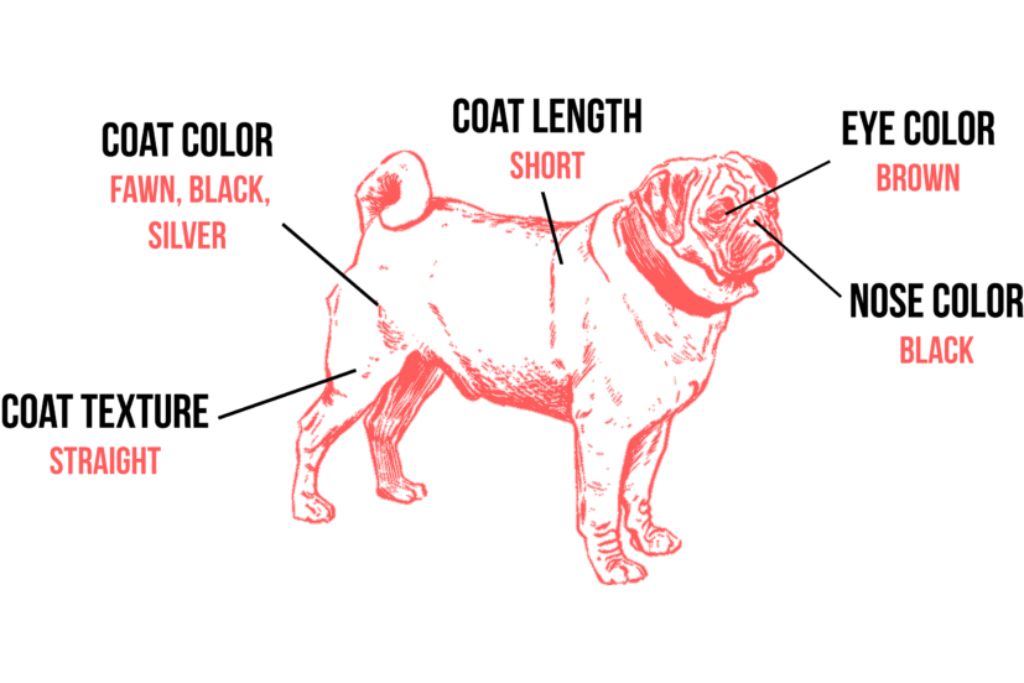
In eighteenth-century prints, Pugs appeared long and lean. However, modern breed preferences lean towards a square and compact body. They have a deep chest and well-defined muscles. These dogs typically have tightly curled tails.
They fall under the small dog breed category. There’s not much difference in the size of a male and a female pug puppy. Here’s their height and weight details:
| Height | 10 to 13 inches |
| Weight | 14 to 18 pounds |
Pugs are known for their distinct short and flat black muzzle, which is often wrinkled. They have moles on their cheeks, known as “beauty spots,” and a noticeable mark on their forehead.
They have two types of ear shapes:
- Rose: This type of ear is smaller and folded with the front edge against the head.
- Button: This type of ear is standard size and is not folded. It is preferred in breeding.
Pugs have strong, straight legs of moderate length set well under their bodies. Their shoulders are moderately laid back, with strong ankles, small feet, and well-split toes. They typically have a slight under-bite, with lower teeth protruding slightly more than the upper teeth.
Pug Colors and Coat Type
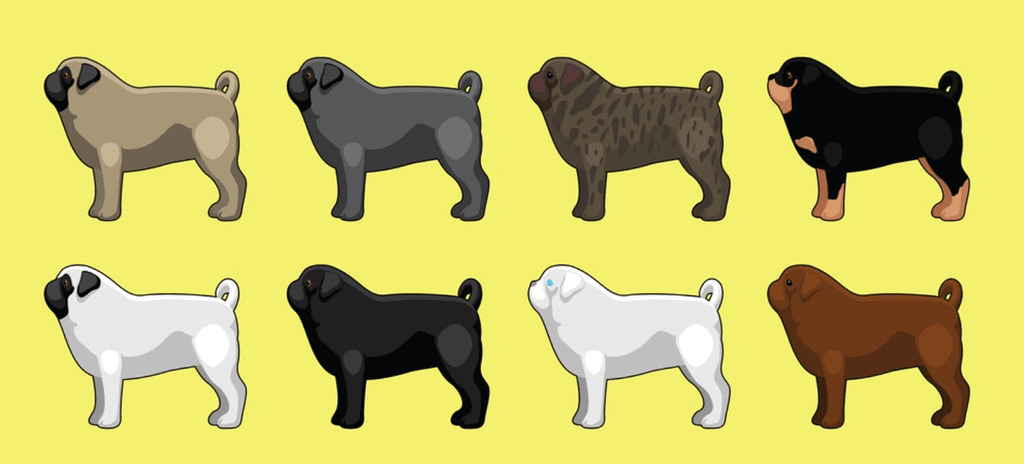
Pugs have a short, smooth, and glossy double coat. Their coats usually come in two main Pug colors:
- Fawn with a black mask
- Solid black Pugs
The fawn coat can vary from a warm apricot to a less common silver shade. You may also find white Pugs, but they are rare. White Pugs have albinism, so remember that their coat color isn’t actually white.
Characteristics and Temperament
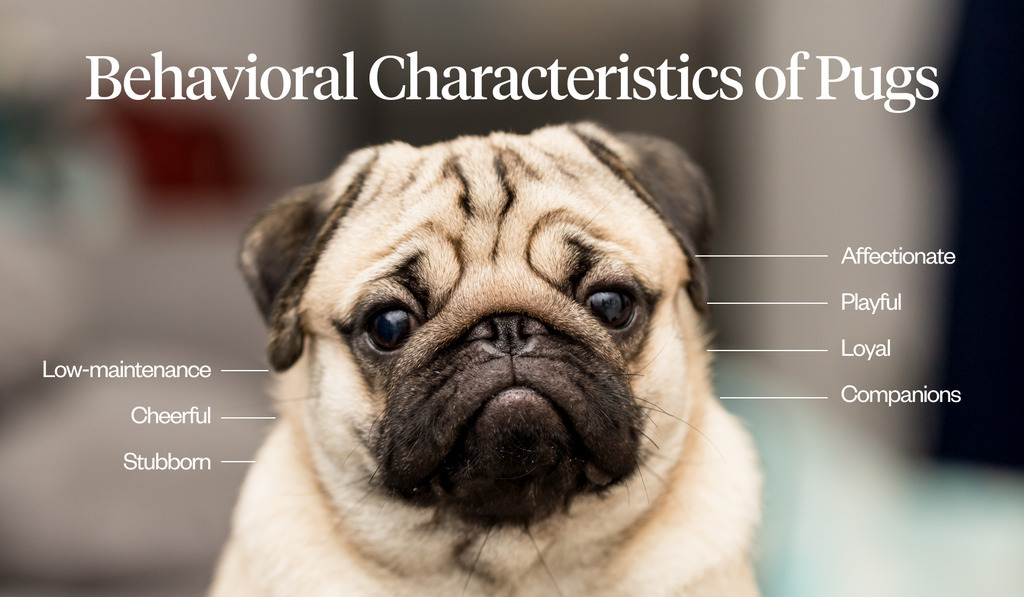
Pug puppies are known for their affectionate and cheerful nature. Their happiest spot is right beside you. Bred as companions, they’re perfectly content snuggling on your lap all day long and may even hop into bed with you.
But beware: These dogs tend to snort, wheeze, and snore. They’ll make it clear if they’re not getting enough love or if left alone for too long. Don’t expect a pug to hunt, guard, or fetch. Those activities are not their style.
They adore spending time with people and love to play, although they don’t require as much exercise as some other breeds. A daily walk or some playtime in the yard is usually enough to keep them content.
After a bit of activity, they’re happy to snuggle up for a nap. While they may bark to alert their family of strangers, they’re generally quiet, making them suitable for apartment living.
To sum up Pug dog breed characteristics and behavior,
- Pugs are very affectionate
- They are overall friendly and good with kids
- These dogs are also pet-friendly
- Pugs need a medium amount of exercise
- They are very playful
- These dogs have an average amount of energy
- They have medium-level trainability and intelligence
- Pugs don’t bark much
- They are heavy shedders
Napoleon’s wife, Josephine, had a faithful and protective Pug named Fortune.
Health and Nutrition
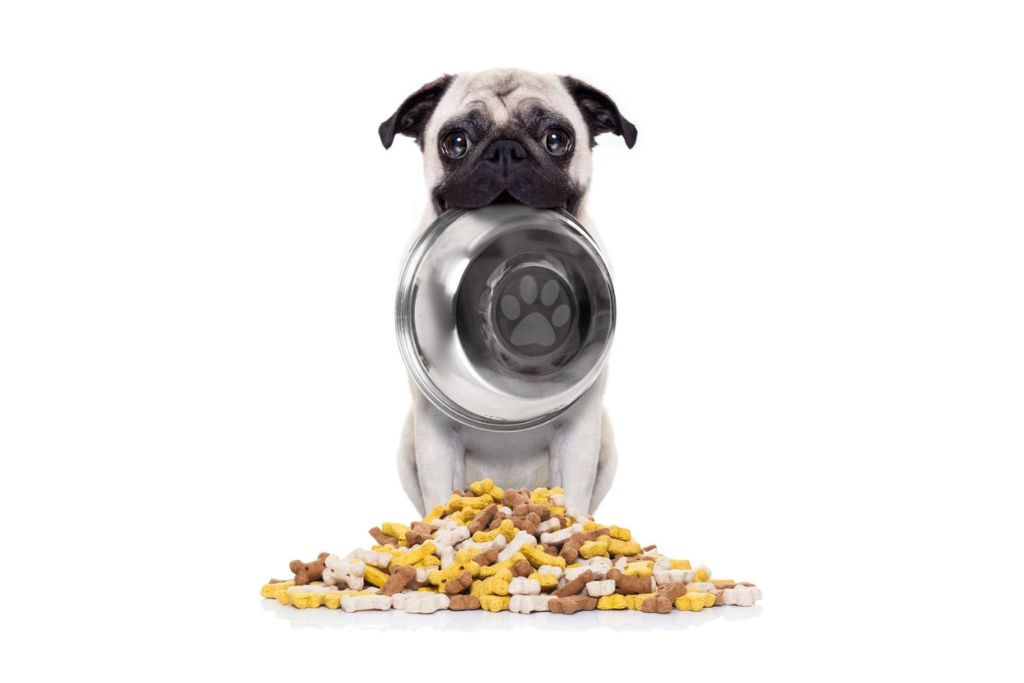
Feeding your Pug puppy a proper diet is necessary for their health, especially since obesity is common among this breed. To help your puppy maintain a healthy weight, consult your vet about a weight management plan.
Make sure you’re feeding them food suitable for their life stage. You can also give them homemade healthy food like fruits and vegetables for dogs.
Feeding Tips:
- Pugs do well with 2 or 3 small meals a day.
- Because of their mouth shape, choose dry food with kibble size and shape to prevent choking. Some brands offer foods designed for the breed, which may help manage specific health issues.
- Consult your vet for advice on breed-specific food and the best kibble size.
How Much to Feed:
- Avoid overfeeding by basing portions on your dog’s body size, typically 1 to 1.5 cups of food daily.
- Your vet and dog food brand recommendations will help determine the exact amount based on your dog’s health needs and lifestyle.
Nutritional Tips:
- Fish oil supplements can help manage skin allergies.
- Joint supplements containing glucosamine and chondroitin are beneficial for arthritis or joint problems.
Common Health Problems
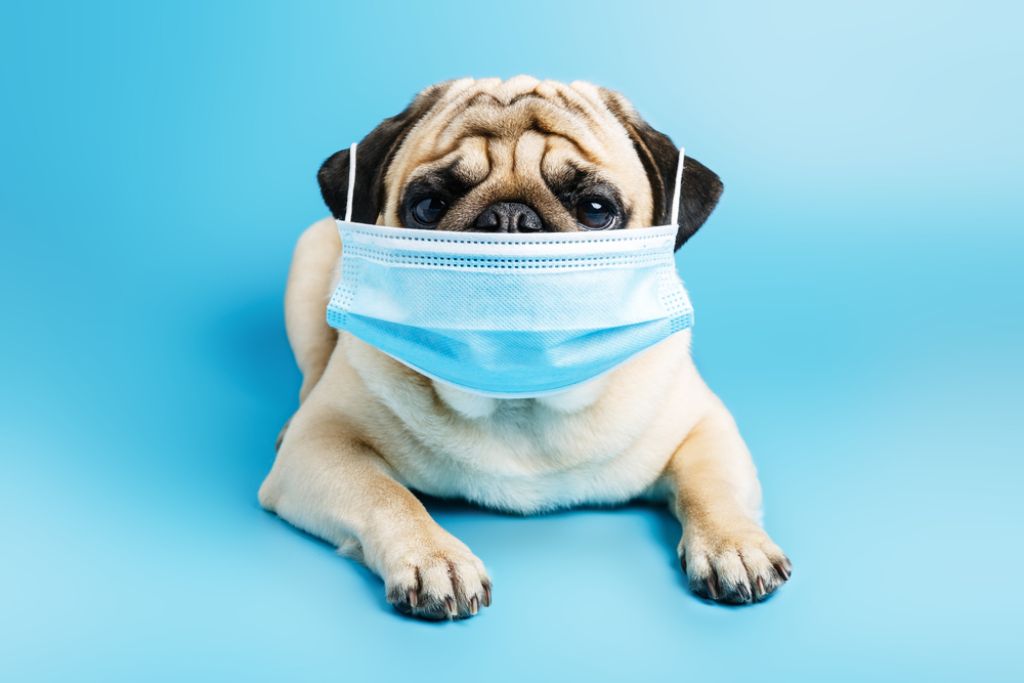
Pug puppies are prone to several health issues, many of which stem from their unique facial structure. Fortunately, most of these problems can be managed with the help of a veterinarian.
- Overheating
Due to their flat faces, Pugs have smaller upper respiratory tracts, making it harder for them to breathe. They’re more susceptible to overheating, so it’s essential to:
- Avoid taking them out during the hottest parts of the day.
- Limit strenuous exercise in hot weather.
- Make sure they always have access to cool, clean water.
- Keeping them at a healthy weight reduces breathing difficulties and the risk of overheating.
- Allergies and ear infections
They are prone to skin allergies and ear infections due to their narrow ear canals and skin folds. Regular cleaning of skin folds and ears, along with veterinary care and preventive bathing, can help manage these issues.
- Respiratory distress
Their narrow airways make Pugs prone to respiratory distress, especially when stressed. If you notice heavy or distressed breathing, seek immediate veterinary attention. Surgery to widen their nostrils or correct an elongated soft palate may be recommended.
- Dental disease
Crowded and crooked teeth can lead to dental disease. Daily tooth brushing and annual dental cleanings by a veterinarian are essential for maintaining dental health.
- Legg-calvé-perthe disease
This condition affects the hips, causing lameness and pain. Surgery is usually necessary to remove the affected portion of bone and alleviate pain.
- Eye injuries
Pugs’ shallow eye sockets increase the risk of eye injuries. Any eye injury should be treated as an emergency to prevent permanent damage or loss of vision.
Behavior and Training

Pugs are generally happy and friendly dogs. They’re often calm but still need regular exercise to stay healthy. Without enough mental stimulation, they may become mischievous or develop bad habits.
They are usually motivated by food, which makes training them relatively easy. While they’re not built for high-energy activities like running, they enjoy low-key exercises like walks or playing fetch.
Pug puppies are usually eager to make you happy and learn quickly with positive training methods. They love treats, but be careful not to overfeed them since they can easily gain weight.
Start training and socializing your pug puppy when they’re young. Introduce them to different animals, people, and places to help them feel comfortable and confident.
When Catholics couldn’t join Freemasons, some formed a secret group called the Order of the Pug in 1740. They picked the Pug as their symbol because Pugs are loyal and trustworthy.
Exercise Needs
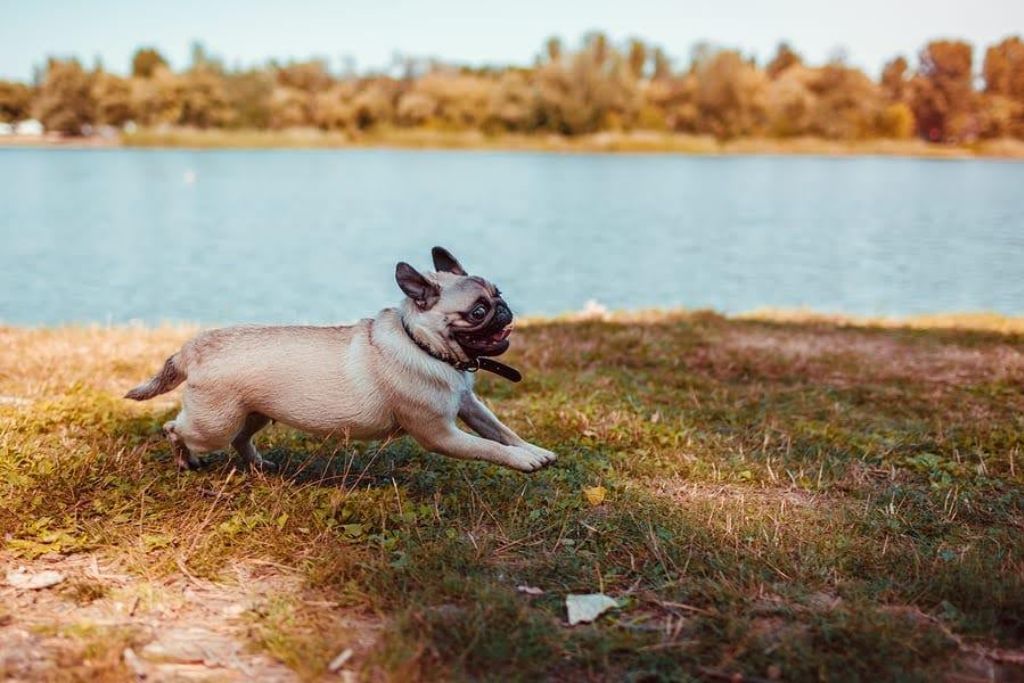
Pugs require a moderate amount of exercise, about an hour each day. A morning and evening walk, along with some active playtime, should do the trick.
They also enjoy engaging in dog sports like agility and rally with their owners. Puzzle toys and interactive games are great for keeping them physically and mentally stimulated.
Be cautious not to push your dog too hard, especially in hot weather. Their short snouts make it difficult for them to cool down by panting, which puts them at risk of heat exhaustion and heat stroke.
Grooming Needs
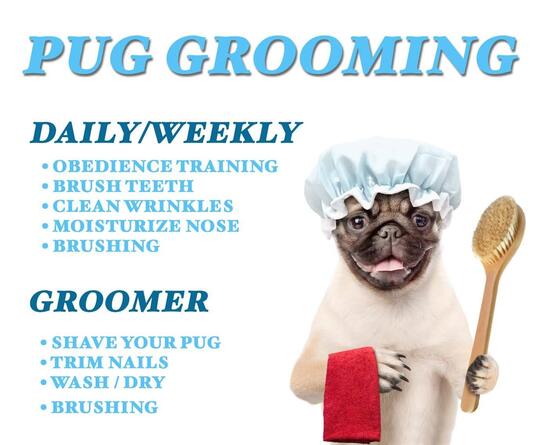
Here are some grooming tips you should follow to keep your dog clean and healthy:
Skin Care
Because of their wrinkly skin, Pugs need consistent skincare. If your dog has skin issues, your vet may recommend weekly baths with special shampoos. Clean their wrinkles regularly with a damp cloth or dog wipes to prevent infections.
Coat Care
Even though Pugs have short coats, they shed a lot. Brushing them weekly can help control shedding.
Eye Care
They are prone to eye problems, so check their eyes regularly for any issues. Use a warm, wet cloth to clean their eyes and dry them afterward to prevent infections.
Ear Care
Pug puppies are also prone to ear infections. Talk to your vet about the best way to clean their ears. Cleaning too often can lead to infections, so follow your vet’s advice carefully.
Are Pugs Hypoallergenic?
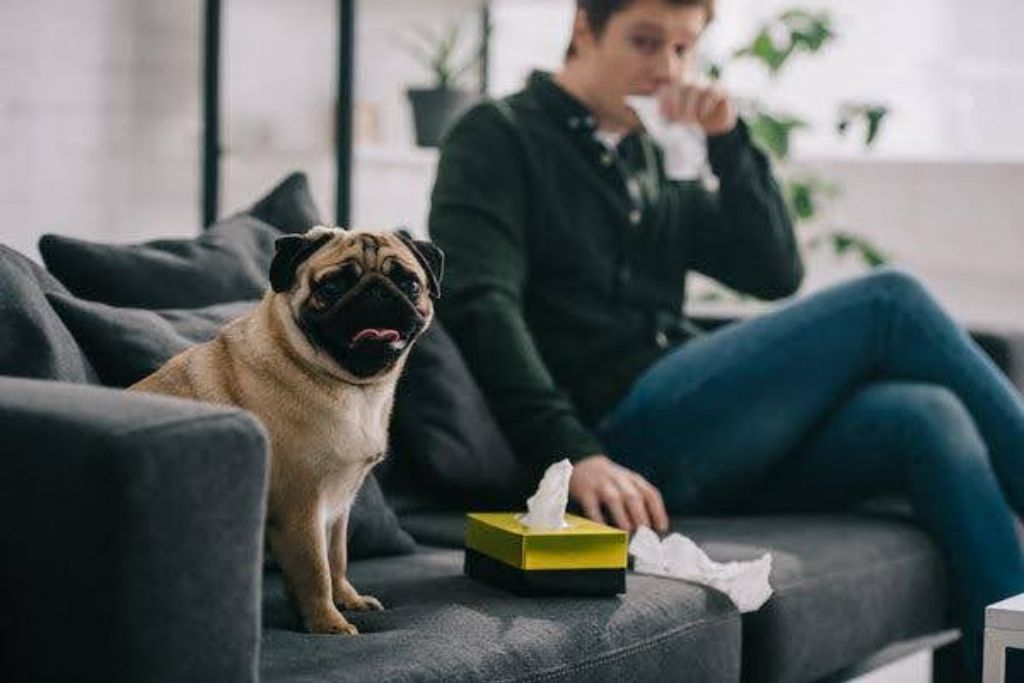
Pugs are not hypoallergenic or less likely to cause allergies. So, if you have severe allergies, owning this breed might not be ideal. However, if your allergies are mild, there are ways to minimize your symptoms around these dogs.
Pug Dog Price
Pugs for sale can cost anywhere between $800 and $1,500 from a reputable breeder. However, quality puppies can cost $3,000 or more. The Pug dog price varies based on factors like the puppy’s age, pedigree, gender, quality, and where the breeder is located.
A group of Pugs is called a “Grumble.”
Pug Life Span
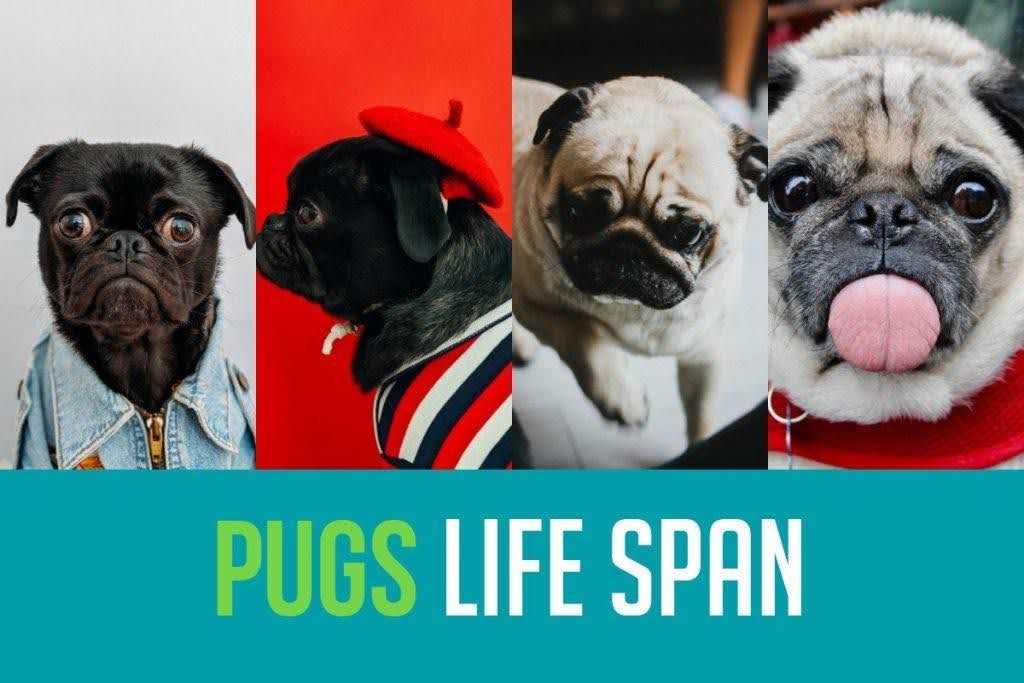
How long do pugs live? According to the American Kennel Club, these dogs typically live around 13 to 15 years.
Females live longer than males. On average, females live about 13.2 years, while males have a shorter lifespan of around 12.8 years.
FAQs
You can easily find Pugs for sale through breeders or adoption agencies.
By selecting a reputable breeder, taking your dog for regular vet visits, and giving them the right food and exercise, you can increase your Pug’s life span.
Yes, they are mostly suitable for staying indoors to avoid the risk of overheating.
These dogs are smart and can easily learn basic commands.
Conclusion
Pugs are wonderful family pets. They are great companions for people who are looking for a cuddle buddy. However, they do require some effort.
Because of their flat faces, Pugs are prone to eye, ear, and skin issues. So, regular grooming and vet check-ups are important for their well-being. If you are ready to take this responsibility, pugs will make amazing pets for your home.
Explore More:








